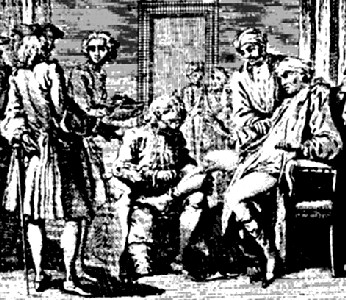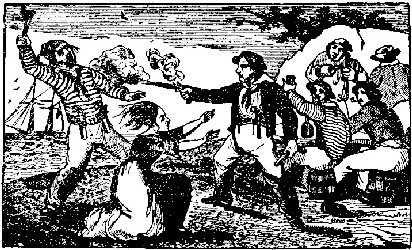
Gangrene Treatment Page Menu: 1 2 3 4 Next>>
Treating Gangrene During the Golden Age of Piracy, Page 2
Causes of Gangrene
Richard Wiseman has much to say on the causes of gangrene, explaining that they "...are various,
viz. whatever destroyeth the natural Heat: as Interception of the motion of the blood is over-strict

Richard Wiseman, Author of Eight chiurgical treatises
[overly tight] Bandage in Wounds and Amputations, want of timely extracting of extraneous bodies in
Gun-shot, &c. from whence Pain and Fluxion [fluid discharge] do arise; so excess of Cold
in hard Winters, also in Old age, and the like.
A Gangrene doth arise also in Phlegmons [inflammations with pus formation], through the unseasonable application of over-cold Medicaments [medicines were thought to have four qualities - hot, cold, wet and dry, which were believed to interact with the four different humors); or for want of timely Digestion [creation of flesh in healing of wounds]; or by excess of Heat, such as becometh caustical, as we find in Carbuncles [abcesses] and all Eschars [sloughs of dead tissue]. But that which most of all contributes to it is the Degeneration of Humours in unsound Bodies: in some of which not only all great Operations, but even the application of a Caustick [medicine that destroys tissue - also called a 'Potential Cautery' at this time], cutting a Corn, or pairing a Nail of a Toe to the quick, will endanger Mortification." (Wiseman, p. 443)
Pierre Dionis clarifies Wiseman's rather arcane description "whatever destroyeth natural Heat" with "distribution of the Blood." He adds a few causes of gangrene to Wiseman's list including "...Diseases, Large Tumours, an Erysipelas [an acute streptococcus bacterial infection], great Inflammations, great Cold, violent Compressions, sudden settlements of malignant Serosities [serus fluids], and the bitings of Venemous Animals..." (Dionis, p. 404)
Tight Bandaging
While different authors cite different causes, tight bandaging is pretty roundly denounced by all the surgical authors that mention the causes of gangrene. Surgeon Matthias Gottfriend Purmann warns us in his book Chirurgia Curiosa of, "Too hard binding and rolling the Limbs in Fractures". (Purmann, p. 207) John Atkins, author of the book The Navy Surgeon makes quite the case against it, using quite a variety of interesting terms to denote the problem.

Bandaging a patient at the Infirmary
"Strict [overly-tight] Bandage is a more common Cause than the former; and is the Occasion of
it in Amputations,
by intercepting the Blood and Spirits repairing thither; whence the Life of it is cut off. The only
Sign discovering to us a Fault of this Kind, is the acute and vehement Pain that instantly succeeds
tort [tight] Rowling...
...Security against a Flux [fluid discharge] should never be owing to strait [tight] Bandage; and when we suspect it to be so, we should give proper and immediate Relief." (Atkins, p. 153)
John Woodall, author of the first English book on sea surgery, the surgions mate, gives a very colorful warning to budding sea-surgeons.
"...beware likewise of over hard binding, for it bringeth astonishment and hazard of a sudden Gangrene and death, it is a generall fault of divers young Surgeons, for many thinke they have never bound hard enough, and yet too loose is a fault, but easily may bee amended, and I advise thee to looke to thy patient often, that his splints gall him not, for that bringeth want of rest, and divers evill accidents depending thereupon, I speake this of mine owne experience, not to my praise..." (Woodall, p. 166)
Signs of Gangrene
Wiseman goes on to give us some detail about the signs that a gangrene has begun in a part including, "...change of the natural colour in the Skin to a pale livid, with dimunition of Tumour; Blisters also arise, and the Part turneth black soon after. In Wounds, the Lips sink and are flaccid; a Gleet [slimy discharge] followeth, and the Flesh within withers; also the Pulse and Sense in the Part do both languish." (Wiseman, p. 443)
He later expands upon the various signs as they relate to their causes.
"If a Gangrene proceed from Pain, the Tumour and preceding Inflammation will shew it, and the sudden sinking of that Tumour is the beginning of the Gangrene. If the Gangrene be from Cold, the Part is first benumbed, then accompanied with a pricking Pain, also a Redness, which by degrees turned black, and a Horrour and Rigour seizeth upon the Patient. If it be from Interception of the Spirits by reason of over strict Bandage, there is neither Fluxion nor Pain, but a Flaccidity joyned with an Insensibility in the Part. If it be from Old age, the Patient is lean, nature visibly decayed, his Legs and other extremities are first seized, and the Part is most commonly without Tumour." (Wiseman, p. 444)
John Atkins provides a more succinct and vivid description.
"…the Signs that evidence it [gangrene], are a pale and livid Colour of the Flesh and Skin, Vesicles spread up and down, and a stinking of the Tumor; but chiefly, it is known from the little Share of Heat, Sense, or Feeling, that is found in the Part, and the fœtid Smell that arises in Proportion as those are extinguished." (Atkins, p. 152)
By now I think you'll have quite a good idea of how gangrene appeared through the eyes of late 17th and early 18th century authors. (You are no doubt sorry I didn't post an image for this section.) Many of the authors mention the loss of heat in the gangrened part, which makes sense since the blood flow to the gangrened part has ceased. Recognizing this lack of warmth was an important part of not confusing a gunshot wound with gangrene.
Gunshot Wounds Confused With Gangrene
"In our Sea-fights oftentimes a Buttock, the Brawn of the Thigh, the Calf of the Leg, are torn off by Chain-shot and Splinters. All these are contused Wounds, and look black, and do often deceive the unexperienced Chirurgeon, he taking them by their aspect to be gangrened, and by dressing them as Mortifications with Ægyptiac. [a mixture of copper acetate (verdigris), vinegar, and honey] and spir. vini [a rectified spirit distilled from wine], doth certainly sphacelate them; and those persons die miserably afflicted." (Wiseman, p. 428)
Wiseman is warning surgeons not to treat a regular gun shot or cannon shot wound that is dark in color as if it were a gangrene because it may actually produce a gangrene/sphacelus! John Atkins explains how this confusion might arise in a bit more detail.

[Pirate] Gibbs shooting
a Comrade, From A Pirate's Own Book, by Charles Ellms
"When Gunshot was novel, these Wounds, by their livid Colour, were taken to be gangrened or
poisoned; and not unlike the former; for we find the Extinction of Heat is owing to the Greatness of
the Contusion, (as the Ball or Splinter came with greater or less Force, direct or aslant,)..."
(Atkins,p. 150)
The only period author I have read that suggests that gunshot wound is related to gangrene is John Woodall. He does not come right out and say gun shot wounds are always gangrenous, but he seems to lean towards their being more susceptible to gangrene than other wounds.
"The most notable differences I have ever observed twixt a wound made with Gunshot, and an other contused wound, is onely a steeling flux of bloud, and a dangerous disposition to a Gangrene, which two accidents warily prevented the Cures of such wounds differ nothing from ordinary wounds contused. " (Woodall, p. 142)
Woodall does suggest that any wound with contusion is similarly susceptible.
Wiseman advises the surgeon on how to consider a gunshot wound that looks gangrenous and discern whether it actually is gangrened or not.
"Whereas if they be considered rightly, though they look like Flesh long hang'd in the Air, of a dry blackish colour, yet they have warmth, and by Lenients [soothing medications or applications], as is prescribed in Simple Gun-shot Wounds, they would digest, separate their Sloughs [dead outer skin], and incarn [form tissue inside the wound]. But they are slow in Digestion, and require good Fomentations and Embrocations to cherish the native heat, which is much weakened by so great a loss of Substance." (Wiseman, p. 428)
For more on how Wiseman treats gunshot wounds, see the discussion of Curing Bullet Wounds in the Golden Age of Pyracy.
Next we'll look at how they went about trying to cure gangrene.

